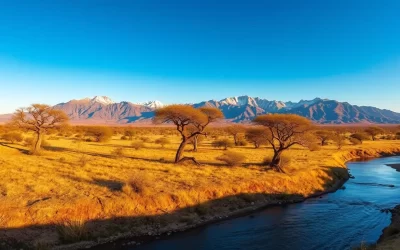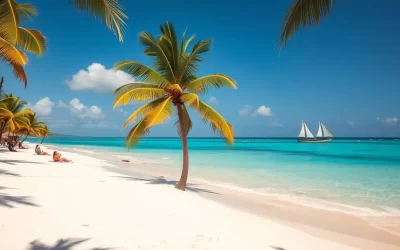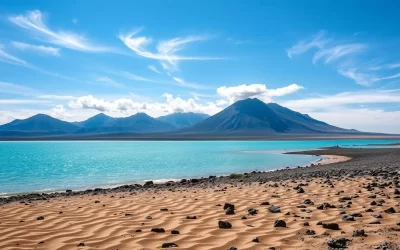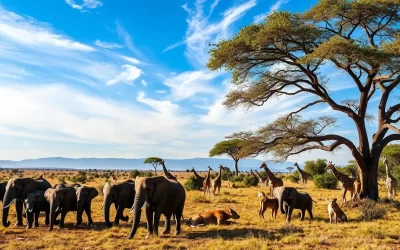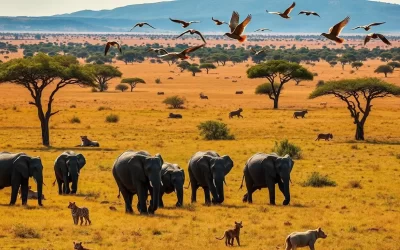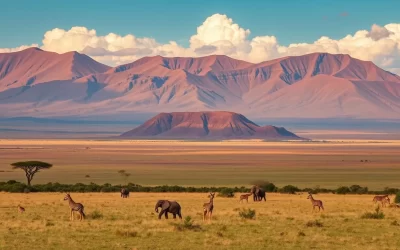Imagine witnessing the great migration in the Masai Mara, one of Africa’s most renowned wildlife reserves. Kenya is a treasure trove of experiences, offering more than just safari adventures. With its diverse wildlife, rich cultural heritage, and breathtaking landscapes, you’re in for an unforgettable journey.
From the safari capital of the world to the serene beaches and challenging mountain treks, Kenya has something for every kind of traveler. Whether you’re exploring the bustling streets of Nairobi or relaxing on the pristine shores of Lake Turkana, you’re part of a journey that showcases the site of Kenya’s incredible diversity.
You’re about to embark on a curated journey through Kenya’s top experiences, tailored to your interests. Get ready to uncover the essence of this remarkable country.
Discovering Kenya’s Natural Wonders
From majestic mountains to expansive savannahs, Kenya’s natural beauty is a treasure trove of exciting experiences. As you explore this incredible country, you’ll encounter a diverse range of landscapes and ecosystems that are home to an astonishing variety of wildlife.
The Great Rift Valley: A Geological Marvel
The Great Rift Valley is one of Kenya’s most impressive natural wonders, stretching over 6,430 kilometers across East Africa. This massive geological formation was created approximately 40 million years ago through tectonic plate movement and volcanic activity.
Kenya’s section of the Rift Valley is considered the most beautiful, featuring dramatic escarpments, mountain highlands, indigenous forests, gorges, beautiful lakes, and expansive savannahs. The valley’s diverse ecosystems have created perfect conditions for an incredible variety of wildlife, making it a crucial region for Kenya’s biodiversity and safari experiences.
Kenya’s Diverse Landscapes and Ecosystems
Kenya’s landscapes range from snow-capped mountains and dense forests to arid deserts and tropical beaches, creating a country of extraordinary natural contrasts within relatively small geographical boundaries. This diversity of landscapes supports a wide range of ecosystems, from the highlands to the savannahs, each providing unique experiences for visitors.
As part of this diverse landscape, the Great Rift Valley is not only a significant geological site but also a pivotal region for human evolution, with many important archaeological discoveries providing insights into our earliest ancestors.
Safari in the Masai Mara: Witness the Great Migration
Embark on an unforgettable adventure in the Masai Mara, one of Kenya’s most renowned safari destinations. As you explore this incredible reserve, you’ll have the chance to witness the Great Migration, one of the world’s most spectacular wildlife events.

Best Time to Visit for the Wildebeest Migration
The Masai Mara is home to the annual Great Migration, where approximately 1.5 million wildebeest, along with hundreds of thousands of zebras and gazelles, move through the reserve in search of fresh grazing. For the best migration viewing, plan your visit between July and October when the herds dramatically cross the Mara River.
This period offers a thrilling experience as predators lie in wait, making it a true wildlife spectacle. Timing your visit right is crucial to witnessing this natural wonder.
Hot Air Balloon Safaris Over the Savannah
For a unique perspective of the Masai Mara, consider a hot air balloon safari. Drifting silently above the savannah at sunrise, you’ll spot wildlife from a new vantage point, followed by a champagne breakfast in the bush. This experience offers a magical and serene way to enjoy the reserve’s dramatic landscapes and sprawling savannahs.
Meeting the Maasai People and Their Culture
Beyond the wildlife and landscapes, the Masai Mara provides opportunities to engage with the iconic Maasai people. You can visit authentic Maasai villages to witness traditional dances, learn about their customs and beliefs, and purchase handcrafted beadwork directly from local artisans. This cultural interaction adds a rich layer to your safari experiences in Kenya.
By immersing yourself in the Maasai culture, you’ll gain a deeper understanding of their traditional way of life and their deep connection to the land. This makes your visit to the Masai Mara a truly holistic experience, encompassing both wildlife and cultural experiences.
The Masai Mara stands out as a premier safari destination in Kenya, offering experiences that cater to both first-time safari-goers and seasoned travelers. Whether you’re there to witness the Great Migration or to engage with the local Maasai culture, the Masai Mara is undoubtedly one of the best things to do in Kenya.
Explore Amboseli National Park with Kilimanjaro Views

Imagine witnessing vast herds of elephants against the backdrop of Africa’s highest mountain, Mount Kilimanjaro, in Amboseli National Park. This park is renowned for its dramatic landscapes and diverse wildlife, making it one of the top things to do in Kenya. As you explore Amboseli, you’ll have the opportunity to see a variety of animals, including lions, leopards, cheetahs, and giraffes, all set against the stunning backdrop of Kilimanjaro’s snow-capped peak.
Elephant Encounters in Their Natural Habitat
Amboseli National Park is one of the best places in Africa to observe and photograph elephants up close. The park is home to some of the largest tuskers in Africa, and its relatively compact size and open landscapes make wildlife spotting particularly rewarding. As you venture into the park, you’ll witness vast herds of elephants roaming freely, creating unforgettable experiences. The park’s semi-arid environment means that during the dry season (June to October), animals concentrate around water sources, making them easier to spot.
The elephant encounters in Amboseli are truly a highlight of any Kenyan safari. With patience and a good guide, you can get remarkably close to these majestic creatures, observing their behavior and social interactions in their natural habitat.
Photography Tips for Capturing Kilimanjaro Backdrops
For photographers, Amboseli National Park offers a unique combination of dramatic light, dust, and the stunning backdrop of Mount Kilimanjaro. To capture the best images, consider visiting during the early morning when the light is soft and the skies are clear. The dry season is ideal for photography as the concentration of wildlife around water sources provides ample opportunities for capturing compelling images.
When taking photos, pay attention to the composition, ensuring that the majestic Kilimanjaro peak is balanced with the wildlife in the foreground. Experiment with different angles and perspectives to add depth to your photographs, and don’t forget to capture the intricate details of the animals and their surroundings.
Climb Mount Kenya: Africa’s Second Highest Peak
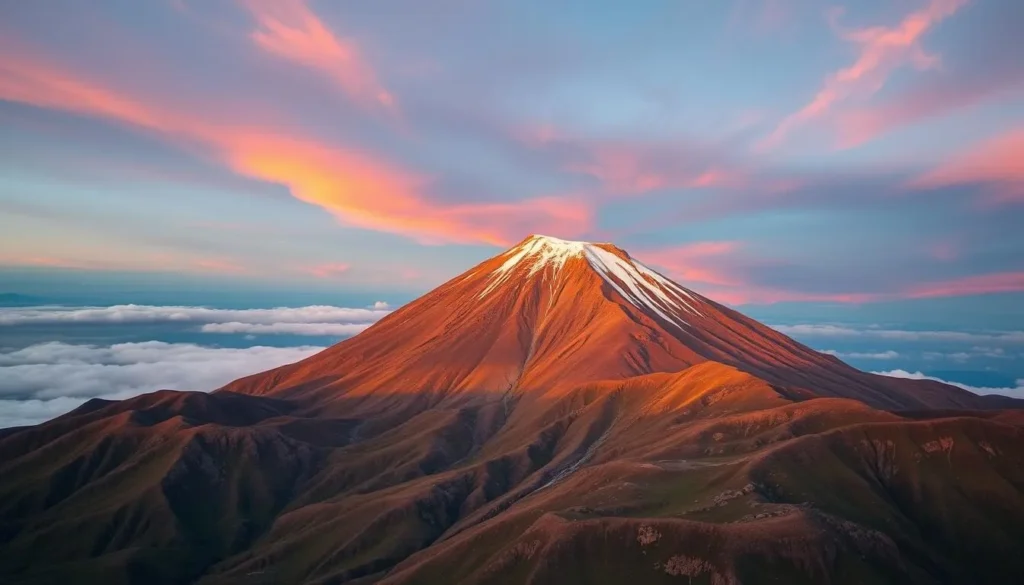
As you embark on the journey to climb Mount Kenya, you are not just scaling a mountain; you’re immersing yourself in a world of diverse ecosystems and breathtaking landscapes. Standing at 5,199 meters, Mount Kenya is Africa’s second-highest peak and a premier destination for trekking and climbing enthusiasts.
Popular Routes and Difficulty Levels
Mount Kenya offers several climbing routes, each with its unique characteristics and challenges. The three main routes are Naro Moru, Sirimon, and Chogoria. Naro Moru is the quickest but steepest route, while Sirimon is considered the most scenic and gradual. Chogoria, on the other hand, is the most beautiful but also the longest route. Most climbers take 4-6 days to complete their journey, allowing for proper acclimatization and enjoyment of the mountain’s diverse landscapes.
The mountain features three main summits: Batian and Nelion, which require technical rock climbing skills, and Point Lenana, which can be reached by fit hikers without specialized climbing equipment. The choice of route depends on your experience level and the kind of experience you’re looking for.
Essential Gear and Preparation Tips
Preparing for a Mount Kenya climbing expedition requires careful planning and the right gear. Essential items include sturdy hiking boots, layered clothing for varying temperatures, and a good quality sleeping bag. It’s also crucial to have a reliable guide or join a guided tour to ensure safety and enhance your experience.
Physical conditioning is another critical aspect of preparing for the climb. Training beforehand can significantly improve your experience on the mountain. Additionally, understanding and respecting the local environment and cultures will enrich your journey and contribute to a positive impact on the destination.
Relax on Diani Beach’s Pristine Shores

Experience the ultimate beach vacation at Diani Beach, renowned for its pristine shores and vibrant marine life. You can unwind on the beach’s powder-white sand, enjoy the turquoise waters, and take part in various water activities.
Diani Beach stands as Kenya’s premier coastal destination, featuring 17 kilometers of powder-white sand and turquoise waters that have earned it the title of “Africa’s Best Beach Destination” for multiple consecutive years. Located just 30 kilometers south of Mombasa, Diani offers the perfect balance between accessibility and tranquility, making it an ideal addition to any Kenya safari itinerary.
Water Sports and Marine Activities
The beach’s crystal-clear waters provide excellent conditions for a wide range of water sports, including snorkeling, scuba diving, kitesurfing, jet skiing, and stand-up paddleboarding for all skill levels. Marine enthusiasts can explore vibrant coral reefs teeming with colorful fish, sea turtles, and occasionally reef sharks, while more adventurous divers might encounter manta rays and whale sharks during the right season.
Luxury Beachfront Accommodations
Diani’s coastline is dotted with luxury beachfront resorts, boutique hotels, and private villas that cater to various budgets while maintaining high standards of comfort and service. Visitors can enjoy sunset dhow cruises, visits to nearby Kisite-Mpunguti Marine National Park, or excursions to sacred Kaya forests that hold cultural significance to the local Mijikenda people.
The beach area maintains a relaxed, unpretentious atmosphere despite its world-class status, with beachfront restaurants serving fresh seafood and international cuisine under swaying palm trees. Whether you’re looking for adventure or relaxation, Diani Beach is a destination that offers unforgettable experiences in a breathtaking setting.
Visit Lake Nakuru National Park’s Flamingo Paradise

With its stunning alkaline lake and varied ecosystems, Lake Nakuru National Park offers an unforgettable safari experience. As a UNESCO World Heritage Site, the park is renowned for its breathtaking landscapes and diverse wildlife.
Lake Nakuru National Park centers around a stunning alkaline lake that has historically been famous for its massive flocks of pink flamingos. While flamingo numbers have fluctuated in recent years due to changing water levels and ecological factors, the park remains an important habitat for both lesser and greater flamingo species.
Wildlife Viewing Beyond Flamingos
Beyond its avian attractions, Lake Nakuru National Park serves as a critical conservation area, housing Kenya’s first rhino sanctuary and currently protecting one of the largest populations of black rhinos in the country. You can spot these magnificent creatures grazing in the early morning on the sweet vegetation along the lake’s edge.
The park offers excellent opportunities to spot elusive leopards, which are frequently seen draped over the branches of fever trees, as well as lions, buffalo, and the endangered Rothschild’s giraffe that was introduced to the park in the 1970s.
Conservation Efforts and Ecological Challenges
Conservation efforts at Lake Nakuru face ongoing challenges, including changing water levels due to upstream deforestation, pollution concerns, and the need to maintain sustainable tourism practices while protecting the fragile ecosystem.
Despite these challenges, the park’s diverse habitats, from lakeshore to woodland and rocky escarpments, create varied ecosystems that support a wide range of wildlife within a relatively compact and easily navigable area.
The park’s proximity to Nairobi (approximately 3 hours by road) makes it an accessible destination for day trips or as part of a longer safari circuit through Kenya’s Rift Valley region.
Cycle or Hike Through Hell’s Gate National Park

Get ready to explore one of Kenya’s most unique national parks, Hell’s Gate, where adventure meets natural beauty. Hell’s Gate National Park is a haven for those who love the outdoors, offering a range of activities that allow you to immerse yourself in its breathtaking landscapes.
Geological Wonders and Hot Springs
Hell’s Gate National Park is renowned for its striking geological formations, shaped by millions of years of geothermal activity. The park’s landscape is dotted with volcanic columns, towering cliffs, and deep gorges, creating a dramatic backdrop for your adventures. You can explore the park’s natural hot springs and steaming vents, which are a testament to the geothermal forces still at work beneath the surface.
The park’s unique geological features, such as Fischer’s Tower and Central Tower, are a result of this volcanic activity. These formations not only add to the park’s natural beauty but also provide a glimpse into the region’s geological history.
Rock Climbing and Adventure Activities
For the more adventurous, Hell’s Gate National Park offers a range of activities, including rock climbing, mountain biking, and hiking. You can climb the park’s volcanic plugs, ride through the open plains alongside zebras and giraffes, or hike through the narrow gorges carved by water. The absence of dangerous predators makes it an ideal destination for families, allowing children to safely experience wildlife viewing in a more interactive way than traditional vehicle safaris.
The park’s relatively small size and proximity to Nairobi make it perfect for day trips or weekend getaways. You can also choose to camp within the park, extending your stay and immersing yourself in the natural surroundings.
Discover Nairobi: Urban Wildlife and Cultural Attractions
Nairobi, Kenya’s bustling capital, is a treasure trove of urban wildlife and cultural attractions waiting to be discovered. As you explore this vibrant city, you’ll find a unique blend of wildlife and cityscape that sets it apart from other capitals around the world.

Nairobi National Park: Safari in the City
Nairobi stands as one of the world’s most unique capital cities, where you can spot rhinos and lions against a backdrop of skyscrapers at Nairobi National Park, the only national park located within a major city’s boundaries. This park offers a safari experience like no other, with the city’s skyline as a stunning backdrop.
Sheldrick Wildlife Trust and Giraffe Centre
The Sheldrick Wildlife Trust offers visitors the chance to observe orphaned elephant calves during their daily mud baths, learning about conservation efforts and even adopting an elephant to support their rehabilitation and eventual return to the wild. At the Giraffe Centre, you can come face-to-face with endangered Rothschild’s giraffes, feeding them from an elevated platform that puts you at eye level with these gentle giants while supporting breeding programs.
Museums and Cultural Sites
Nairobi’s National Museum showcases Kenya’s rich cultural heritage through impressive exhibits on human evolution, tribal artifacts, and natural history. For authentic cultural experiences, visit the Bomas of Kenya to witness traditional dances and music from Kenya’s diverse ethnic groups, or explore the vibrant Maasai Market to purchase handcrafted souvenirs directly from local artisans.
With its unique blend of wildlife and cultural attractions, Nairobi is a city that has something for everyone. Whether you’re interested in animals, history, or simply experiencing the local culture, Nairobi is a destination that will leave you with unforgettable experiences.
Explore the Historic Lamu Island

Discover the charm of Lamu Island, one of East Africa’s best-preserved Swahili settlements. As a significant cultural destination, Lamu Island is part of the top things to do in Kenya for those interested in history and tradition.
Swahili Architecture and Cultural Heritage
Lamu Town, the island’s main settlement, is a UNESCO World Heritage Site, renowned for its unique Swahili architecture. The town’s buildings, constructed from coral stone and mangrove timber, feature intricately carved wooden doors and hidden courtyards, reflecting a rich cultural heritage that has evolved over 700 years. As you wander through the narrow streets, you’ll experience the tranquility of a car-free environment, where donkeys and dhows are the primary modes of transportation.
The Lamu Museum and the 19th-century Lamu Fort are must-visit sites, offering insights into the island’s history and cultural practices. If you’re visiting in August, you might catch the annual Lamu Cultural Festival, which celebrates the island’s traditions with music, dance, and local cuisine.
Dhow Sailing and Beach Experiences
One of the most memorable experiences on Lamu Island is sailing on a traditional dhow. Whether you’re on a sunset cruise, fishing expedition, or day trip to nearby islands like Manda and Kiwayu, dhow sailing offers a unique perspective on the island’s beauty. Shela Beach, with its pristine white sands and clear waters, is perfect for swimming and relaxation, providing a tranquil contrast to the cultural richness of Lamu Town.
The island’s beaches, with dazzling coral reefs, offer a wealth of activities, including snorkeling and diving. After a day of exploration, enjoy the local cuisine, which reflects a blend of African, Arab, Indian, and European influences, a testament to the island’s history as a major trading hub in East Africa.
Kenya: Best Things to Do for Adventure Seekers
Adventure awaits in Kenya, with activities that will push your limits and create unforgettable memories. Whether you’re a thrill-seeker or just looking to try something new, Kenya has a diverse range of experiences that cater to all kinds of adventure enthusiasts.
White Water Rafting on the Tana River
For an adrenaline-pumping experience, head to the Tana River, Kenya’s longest river, which offers white water rafting with rapids ranging from Class II to V. Just a couple of hours from Nairobi, you can embark on a thrilling adventure that includes navigating through stunning landscapes. The Tana River is a drop-pool river, providing calm pools to recover between rapids, making it suitable for a range of rafting experiences from half-day excursions to multi-day expeditions.

Bungee Jumping in Sagana
If you’re looking for the ultimate adrenaline rush, Sagana is the place to be. With a 60-meter bungee tower overlooking the Tana River, you’ll experience a heart-stopping free fall followed by a rebound that’s sure to leave you exhilarated. The process involves climbing 220 steps to the top, getting harnessed, and then taking the leap of faith.
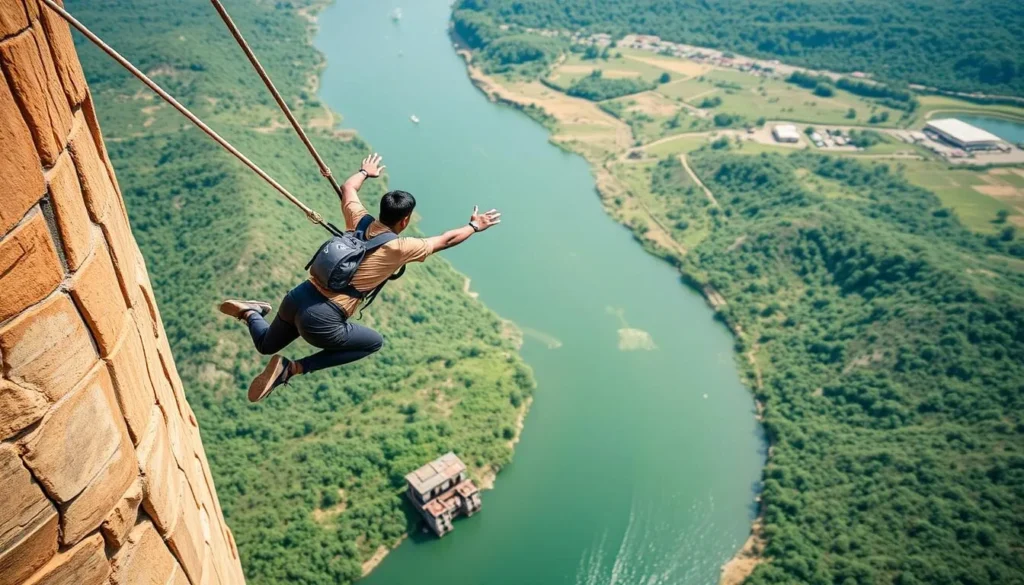
Camel Safaris in Samburu
For a more leisurely adventure, consider a camel safari in Samburu. This unique experience allows you to traverse semi-arid landscapes at a gentle pace, getting up close to wildlife and engaging with traditional Samburu communities. It’s an ideal way to explore Kenya’s northern frontier and enjoy the serene beauty of the Samburu landscape.
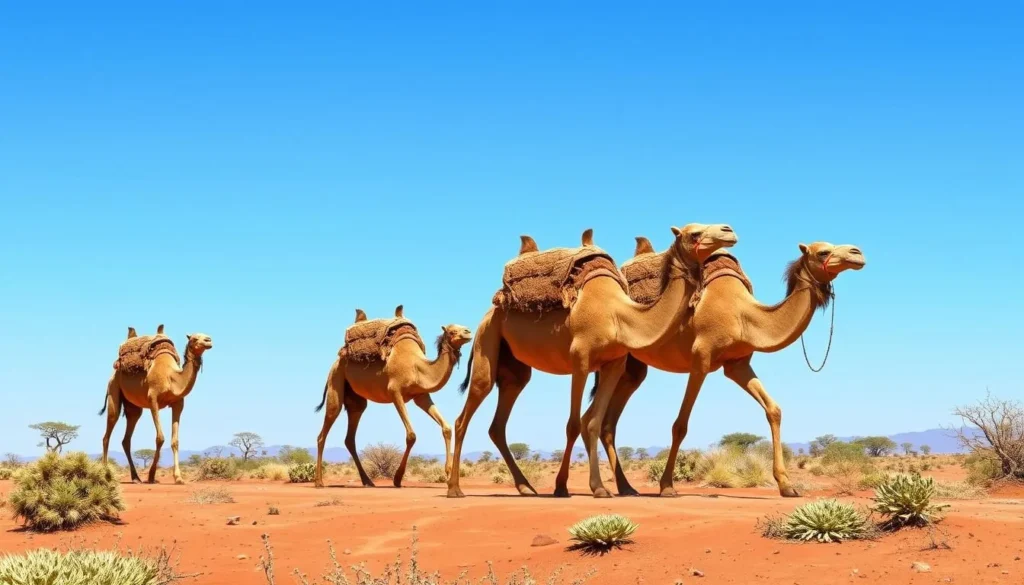
Kenya offers a wide range of activities for adventure seekers, from rock climbing and mountain biking to scuba diving and snorkeling. Whether you’re looking for a relaxing adventure or an adrenaline-packed experience, Kenya has something for everyone.
Lake Turkana: Journey to the Jade Sea

The Jade Sea, as Lake Turkana is affectionately known, is a marvel of nature, presenting a surreal landscape that is both hauntingly beautiful and eerily desolate. Located in the northern frontier of Kenya, this world’s largest alkaline lake and the world’s biggest permanent lake in a desert is a destination that promises an adventure like no other.
Lake Turkana is not just a body of water; it’s an experience that transports you to a different era. The lake’s emerald-blue waters contrast starkly with the arid desert surroundings, creating a visual spectacle that is both unique and captivating.
Cultural Encounters with Indigenous Tribes
The Lake Turkana region is home to several indigenous tribes, including the Turkana, Samburu, El Molo, and Rendille peoples. Each of these communities has distinct cultures, traditions, and ways of life adapted to the harsh desert environment. Visitors can engage in cultural encounters, gaining insight into traditional fishing methods, nomadic pastoralism, and ancient customs that have survived for generations.
Helicopter Safaris Over Dramatic Landscapes
One of the most spectacular ways to appreciate Lake Turkana’s otherworldly beauty is through a helicopter safari. Soaring over volcanic craters, witnessing the stark contrast between the jade waters and the surrounding desert, and accessing remote areas impossible to reach by road, helicopter safaris offer a unique perspective on this UNESCO World Heritage Site.
As you fly over the lake, you’ll witness the dramatic landscapes that make Lake Turkana a truly unique place on our planet. From the rocky outcrops to the arid plains and winding riverbeds, every view is a testament to the natural beauty and geological wonders of this part of Kenya.
Witness Marine Life Along Kenya’s Coast
Exploring Kenya’s coastal waters reveals a world of diverse marine experiences. You can encounter an array of marine life in the crystal-clear waters along Kenya’s 536-kilometer coastline.
Watamu Marine National Park: Snorkeling and Diving
Watamu Marine National Park, established in 1968, is one of Kenya’s first marine protected sites. It encompasses vibrant coral gardens, seagrass beds, and mangrove forests that support over 600 fish species, 110 coral species, and endangered sea turtles.

Deep-Sea Fishing Expeditions
The Kenyan coast is renowned for its deep-sea fishing experiences. You can target “The Big Five” of deep-sea fishing—black marlin, blue marlin, striped marlin, sailfish, and broadbill swordfish—in the waters off Watamu.

Kenya’s coastline along the Indian Ocean harbors some of East Africa’s most pristine marine ecosystems, offering world-class opportunities to encounter diverse aquatic life. Marine conservation initiatives along Kenya’s coast include turtle rehabilitation centers, coral restoration projects, and community-based conservation programs.
Seasonal marine visitors include whale sharks (November to March) and humpback whales (July to September), offering rare opportunities to respectfully observe these magnificent creatures in their natural habitat.
Experience Unique Natural Phenomena
From surreal landscapes to mesmerizing light displays, Kenya’s natural phenomena are a treat for travelers. The country is home to several extraordinary occurrences that create magical, otherworldly experiences for those willing to venture beyond the traditional safari circuit.
Bioluminescent Plankton in Kilifi Creek
Kilifi Creek on Kenya’s coast offers one of the world’s most enchanting natural light shows. Here, bioluminescent plankton illuminate the water with an ethereal blue glow when disturbed, creating a starry underwater universe perfect for night swimming between May and October.

Lake Magadi’s Pink Waters and Hot Springs
Lake Magadi, located in the southern part of Kenya’s Rift Valley, transforms into a surreal pink landscape due to salt-loving algae and high evaporation rates. This creates a Mars-like environment where flamingos gather in thousands, forming living pink islands against the already rosy waters.
The natural hot springs at Lake Magadi provide therapeutic bathing opportunities, with mineral-rich waters believed to have medicinal properties for skin conditions and joint ailments. As you soak in the hot mineral water, you’ll feel your skin become soft and smooth, though it may temporarily turn a shade of chalky white as the mineral-laden water dries.
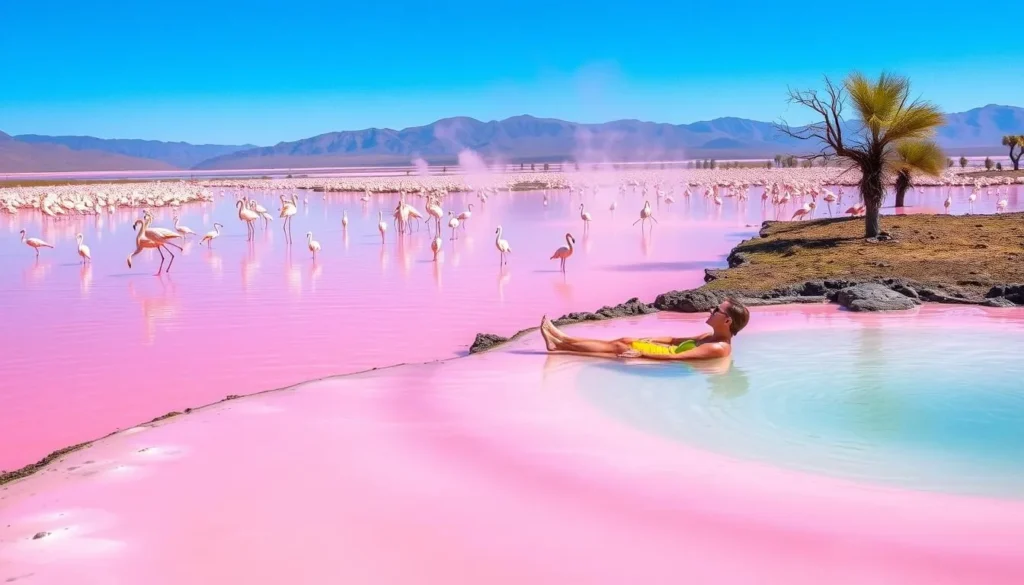
Kenya’s diverse geography gives rise to a range of unique natural phenomena. During certain seasons, millions of butterflies migrate across parts of the country, creating colorful clouds that transform landscapes. In the highlands, misty forests occasionally produce the “Brocken spectre” phenomenon, where a person’s shadow is cast upon clouds or fog, surrounded by a rainbow-like halo.
Kenya’s position on the equator creates unique light conditions and celestial viewing opportunities. Both northern and southern hemisphere constellations are visible in exceptionally clear night skies, particularly in remote areas away from light pollution.
Explore Kenya’s Archaeological and Historical Sites
Beyond its wildlife, Kenya boasts an array of archaeological and historical sites worth exploring. These sites offer a unique window into the country’s rich cultural heritage and historical significance.
Gedi Ruins: The Lost Swahili City
The Gedi Ruins, located near Malindi, are a fascinating archaeological site that reveals a sophisticated lost Swahili city. Built in the 12th century and rebuilt in the 15th and 16th centuries, Gedi showcases advanced architectural techniques and trading connections with distant lands, including China, Venice, and Portugal.
The presence of mosques, a palace, and houses indicates that Gedi was once a prosperous city. Its abandonment in the 17th century is attributed to factors such as coastal raids and a falling water table.

Karen Blixen Museum and Colonial Heritage
The Karen Blixen Museum in Nairobi preserves the former home of the author of “Out of Africa.” The museum offers a glimpse into colonial-era Kenya through its original furnishings, photographs, and beautiful grounds featuring views of the Ngong Hills.
Visitors can experience the history and culture of Kenya’s colonial past, making it a significant historical site. The museum is a must-visit for those interested in Kenya’s rich history and cultural heritage.
Samburu National Reserve: Spot the Special Five
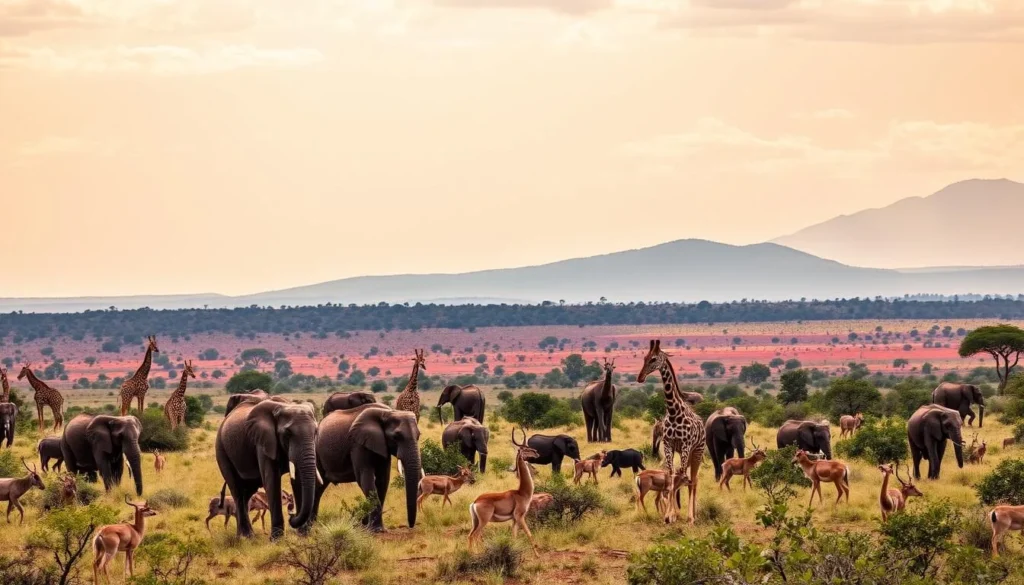
If you’re looking for an off-the-beaten-path safari adventure, Samburu National Reserve is the place to be. Located in northern Kenya, this reserve offers a unique blend of wildlife viewing and cultural experiences that set it apart from more popular destinations.
Unique Wildlife Species of Northern Kenya
Samburu National Reserve is renowned for its “Samburu Special Five” – a collection of rare and fascinating species found only in this region. These include the elegant Grevy’s zebra, the striking reticulated giraffe, the regal beisa oryx, the peculiar gerenuk, and the Somali ostrich. The reserve is also home to a healthy population of elephants, lions, leopards, and cheetahs. The arid landscape and sparse vegetation make wildlife spotting easier, especially along the Ewaso Nyiro River, which creates a lush green ribbon through the dry landscape.
Cultural Interactions with Samburu People
Visiting Samburu National Reserve isn’t just about wildlife; it’s also an opportunity to engage with the local Samburu people. Cultural visits to traditional villages provide a glimpse into the semi-nomadic lifestyle of these pastoralists. You’ll have the chance to learn about their distinct traditions, colorful attire, and intricate beadwork. This cultural interaction is a unique aspect of the Samburu experience, making your safari adventure even more enriching.
The dramatic landscape of Samburu, featuring doum palms, acacia trees, and rocky outcrops against a backdrop of distant mountains, creates a photogenic setting. The golden light of early morning and late afternoon adds to the beauty of the landscape, making it a photographer’s paradise. With fewer visitors than southern parks, Samburu offers a more exclusive safari experience with less crowded wildlife sightings and a stronger sense of wilderness immersion.
Planning Your Perfect Kenyan Adventure
As you plan your Kenyan adventure, consider the diverse experiences this incredible country has to offer. Kenya is widely regarded as the birthplace of safari and is undoubtedly one of Africa’s premier safari destinations. The country boasts unbeatable wildlife regions like the Masai Mara and Amboseli, as well as jaw-droppingly gorgeous beaches along its Indian Ocean coastline.
To make the most of your trip, careful planning is essential. The dry seasons, from January to February and June to October, generally offer the best wildlife viewing, while the green seasons provide lush landscapes and fewer tourists. For first-time visitors, combining the Masai Mara with either Amboseli or Samburu creates an excellent wildlife circuit.
Kenya’s excellent infrastructure allows for various travel styles, from scheduled flights between major parks to private charters, road transfers, or guided driving safaris. Accommodation options span the full spectrum, from luxury lodges and tented camps to mid-range hotels and budget-friendly options. Many properties offer unique experiences like walking safaris, night drives, or cultural interactions.
Consider adding at least 3-4 nights on Kenya’s coast after your safari to relax and process the incredible experiences. With options ranging from developed beaches near Mombasa to the more secluded northern coast around Lamu, you’ll find the perfect spot to unwind. Don’t forget to pack appropriately for Kenya’s varied climates, and research lodges and operators with strong conservation credentials to ensure your visit contributes positively to wildlife protection and local development.
By planning carefully and being mindful of responsible tourism practices, you can have a truly unforgettable Kenyan adventure that leaves a positive impact on the country and its people.
The above is subject to change.
Check back often to TRAVEL.COM for the latest travel tips and deals.

